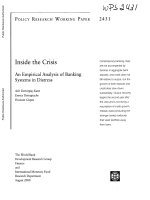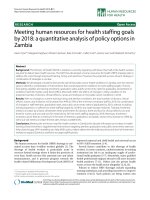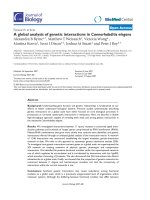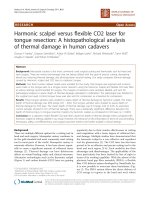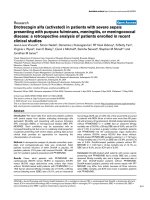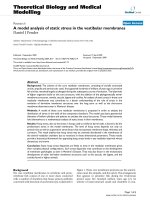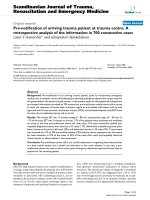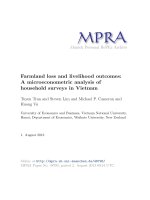A longitudinal analysis of port systems in asia
Bạn đang xem bản rút gọn của tài liệu. Xem và tải ngay bản đầy đủ của tài liệu tại đây (2.93 MB, 323 trang )
A LONGITUDINAL ANALYSIS OF PORT SYSTEMS IN ASIA
JOYCE LOW MEI WAN @ PHAN MEI LING JOAN
NATIONAL UNIVERSITY OF SINGAPORE
2008
A LONGITUDINAL ANALYSIS OF PORT SYSTEMS IN ASIA
JOYCE LOW MEI WAN @ PHAN MEI LING JOAN
(B.B.A (Hons), M.Sc. (Mgt), NUS)
A THESIS SUBMITTED
FOR THE DEGREE OF DOCTOR OF PHILOSOPHY
DEPARTMENT OF INDUSTRIAL AND SYSTEMS ENGINEERING
NATIONAL UNIVERSITY OF SINGAPORE
2008
i
CONTENTS
CONTENTSCONTENTS
CONTENTS
List of Tables v
List of Figures vii
Acknowledgments viii
Summary ix
Chapter 1 Introduction 1
1. Background
1.1 Research Scope and Objectives
1.2 Structure of Dissertation
Chapter 2 An Empirical Investigation on the Cargo Traffic 11
Performances in East Asian Ports
2. Introduction
2.1 Model of Analysis
2.2 Empirical Analysis at the Aggregate Port Industry Level
2.2.1 Data Description and Sample
2.2.2 The Variables
2.2.3 The Results
2.2.4 Implications of Findings
2.3 Cluster Analysis at the Disaggregate Individual Port Level
2.3.1 Seaport Clusters
2.3.2 Airport Clusters
2.4 Discussions
2.5 Conclusions
ii
Chapter 3 Assessment of Hub Status among Major Asian Ports 68
from A Network Perspective
3. Introduction
3.1 Literature Review
3.2 Model Components
3.2.1 Port Connectivity Index
3.2.2 Port Cooperation Index
3.3 The Case Studies
3.3.1 Alpha Shipping Lines
3.3.2 Gamma Shipping Lines
3.2.2 Beta Shipping Lines
3.4 Discussions
3.4.1 Qualitative Analysis of Empirical Results
3.4.2 Robustness of Analysis
3.4.3 Key Factors Influencing Port Competitiveness
3.4.4 Importance of Inter-Port Relationship to Port Traffic
3.5 Conclusions
Chapter 4 The Changing Landscape of the Airport Industry and its 104
Strategic Impact on Air Hub Development in Asia
4. Introduction
4.1 Literature Review
4.2 The Model
4.2.1 Differentiated Downstream Market
4.2.2 Undifferentiated Downstream Market
4.3 Pricing and Capacity Decisions at an Airport Hub
4.3.1 Differentiated Downstream Market
iii
4.3.2 Undifferentiated Downstream Market
4.4 Strategic Directions
4.5 Conclusions
Chapter 5 Factor Substitution and Complementarity in the 138
Asia Airport Industry
5. Introduction
5.1 The Model
5.2 Parameters Estimation and Results
5.3 Discussions
5.4 Conclusions
Chapter 6 Efficiency Assessments of Asia Pacific Airports 157
6. Introduction
6.1 The Data Envelopment Analysis Method
6.1.1 Models Forms and Efficiency Scores
6.2 Data and Variable Descriptions
6.3 Empirical Analysis
6.3.1 Efficiency Results without Virtual Airport
6.3.2 Efficiency Results with Virtual Airport
6.4 Discussions
6.5 Conclusions
Chapter 7 Roles of the Airport and Logistics Services on the 187
Economic Outcomes of an Air Cargo Supply Chain:
Evidences from Hong Kong and Singapore
7. Introduction
7.1 Literature Review
7.2 Research Aims and Hypotheses Development
iv
7.3 Research Methodology
7.3.1 Air Cargo Supply Chain Operations Reference Model
and Performance Measures
7.3.2 Principles of the Accelerator and Multiplier
7.3.3 Data Descriptions
7.4 Results and Discussions
7.4.1 Hypotheses Testing
7.4.2 Quantifying the Accelerator and Multiplier Effects
7.5 Conclusions
Chapter 8 Conclusions 215
8. Summary
8.1 Suggestions for Further Research
References 223
Appendix A Port Descriptions in Brief 239
Appendix B Review of Existing Methodologies Used in the Port Literature 264
Appendix C Multicollinearity Diagnostics for Port Performance Regressions 280
Appendix D Standard Capital Productivity and Economic Volume Plots 282
Appendix E Translog Production Function 293
Appendix F Selected Port and Logistics Industries Data 295
Appendix G Author’s Publications 311
v
LIST OF TABLES
LIST OF TABLESLIST OF TABLES
LIST OF TABLES
Table 2-1 Regression Results for Seaport Performances, 1994 – 2006 31
Table 2-2 Regression Results for Airport Performances, 1999 – 2005 32
Table 2-3 Results for Reduced Seaport Regression Models, 1994 – 2006 33
Table 2-4 Results for Reduced Airport Regression Models, 1999 – 2005 33
Table 2-5 The Influences of Capital, Labor and Economic Performance on 35
Sea Cargo Traffic, 1994 –2006
Table 2-6 The Influences of Capital, Labor and Economic Performance on 36
Airfreight Traffic, 1999 –2005
Table 3-1 NHPA Framework on Hub Status Assessment 72
Table 3-2 Number of O-D Pairs Served by Selected Ports and Their Connect- 82
ivity indices, Alpha Shipping Lines
Table 3-3 Cooperation among Ports and the Aggregate Cooperative Index, 83
Alpha Shipping Lines
Table 3-4 Number of O-D Pairs Served by Selected Ports and Their Connect- 85
ivity indices, Gamma Shipping Lines
Table 3-5 Cooperation among Ports and the Aggregate Cooperative Index, 86
Gamma Shipping Lines
Table 3-6 Number of O-D Pairs Served by Selected Ports and Their Connect- 88
ivity indices, Beta Shipping Lines
Table 3-7 Cooperation among Ports and the Aggregate Cooperative Index, 89
Beta Shipping Lines
Table 3-8 Port Attributes Data of Major Asian Ports, 2004 96
Table 3-9 Rotated Factor Loadings and Communalities (Varimax Rotation) 97
Table 3-10 Factor Score Coefficients 98
Table 3-11 Factor Scores of Selected Ports 98
Table 3-12 Seaport Specific versus Airport Specific Variables 103
Table 4-1 Major Airport Developments and Expansions in Asia, 1994–2008 108
vi
Table 5-1 Parameter Estimates for Equations (6.11) and (6.12) 148
Table 5-2 Average Allen Partial Elasticities of Substitution 148
Table 5-3 Average Price Elasticities of Input Demand 149
Table 6-1 Literature on Airport Efficiency using DEA 161
Table 6-2 Asia Airports’ DEA Efficiency Results without Virtual Airport 177
Table 6-3 Asia Airports’ DEA Efficiency Results with Virtual Airport 181
Table 7-1 Traffic Volume at Major Airports in the World, 2006 190
Table 7-3 Cargo Traffic, Capital Outlay and Value-Add at Chek Lap Kok 210
Airport
Table 7-4 Cargo Traffic, Capital Outlay and Value-Add at Changi Airport 210
vii
LIST OF FIGURES
LIST OF FIGURESLIST OF FIGURES
LIST OF FIGURES
Figure 1-1 Factors Affecting Port Development Examined in the Dissertation 10
Figure 2-1 Seaport Clusters – Waterside Operations 40
Figure 2-2 Seaport Clusters - Quayside Operations 44
Figure 2-3 Airport Clusters – Airside Operations 49
Figure 2-4 Airport Clusters – Landside Operations 53
Figure 3-1 NHPA Modeling Process and Data Requirements 71
Figure 3-2 Representative Network of Port i and Port j 75
Figure 3-3 Example on Network of Perfect Complementary Relationship 78
Figure 3-4 Example on Network of Perfect Competitive Relationship 79
Figure 3-5 Port Classifications in the NHPA Framework, Alpha Shipping 84
Figure 3-6 Port Classifications in the NHPA Framework, Gamma Shipping 87
Figure 3-7 Port Classifications in the NHPA Framework, Beta Shipping 89
Figure 3-7 A Consolidated Partial Liner Network 93
Figure 3-8 Port Classifications in the NHPA Framework (consolidated) 94
Figure 4-1 Optimal Capacity for Cost Function with Different Degrees of 135
Convexity
Figure 4-2 Optimal Capacity for Delay Function with Different Degrees of 136
Convexity
Figure 6-1 Relationship between Different DEA Model Variants and 165
Efficiency Measures
Figure 6-2 Overall Efficiency Trend among Major Airports in Asia Pacific 175
Figure 6-3 Allocative Efficiency Trend among Major Airports in Asia Pacific 176
Figure 6-4 Technical Efficiency Trend among Major Airports in Asia Pacific 176
Figure 7-1 Air Cargo Supply Chain Operations Reference (ACSCOR) Model 201
Figure 7-2 Accelerator Effect of Airport Traffic in Hong Kong and Singapore 211
Figure 7-3 Multiplier Effect of Airport Capacity Investment in Hong Kong 212
and Singapore
viii
ACKNOWLEDGEMENTS
ACKNOWLEDGEMENTSACKNOWLEDGEMENTS
ACKNOWLEDGEMENTS
It is a great pleasure to thank the many people whose intellectual, moral and
operational support have made this dissertation possible.
I am utmost grateful to my main advisor, Associate Professor Tang Loon
Ching, for giving me this opportunity to work on a research area of my interest under
his supervision. Throughout the arduous course of research, his profound insights,
ideas and questionings have simulated in-depth contemplation, which has
significantly shaped the thrust and direction of the dissertation. His unfailing
forgiveness for my many drastic blunders and the time and attention he has put in to
critically comment on my work will always be remembered. I would also like to
express my appreciation to my co-supervisor, Dr. Yuan Xue-Ming, who has always
been encouraging and supportive. I am particularly thankful for the long hours he has
spent with me in busy schedule going through the technical details in this dissertation.
I wish to thank my Oral Qualifying and dissertation examiners, Prof. Ang
Beng Wah, Dr. Ng Szu Hui, Assoc. Prof. Tan Kay Chuan and the anonymous external
examiner for providing me with constructive comments for my research. Not
forgetting my fellow classmates in the Quality and Reliability Engineering Laboratory
and the many academic and support staffs in the department who have made my five-
year studies in the faculty memorable and rewarding. Last but not least, thank you
Shao Wei and Boon Chuan for your technical and moral support.
Joyce M.W. Low
@ Phan Mei Ling Joan (Miss)
First submission: 31
st
July 2008
Revised submission: 31
st
May 2009
ix
SUMMARY
SUMMARYSUMMARY
SUMMARY
Competitive seaports and airports are vital for smooth flow of trade and form
the backbone of an economy’s prosperity. This dissertation is organized into three
distinct but related parts, which together, addresses some of the recent advances in the
Asian port systems. Some internal and external factors that favor the developments of
hub port are identified in the course of research.
Part 1 examines the changing landscape of the port industry in Asia and the
associated implications on port competitiveness. An econometric model is applied to
investigate the relative contributions of production elements, scale operations and
economic conditions to seaport and airport performances over the recent years,
followed by a clustering analysis that groups the ports according to their capital
intensities and throughputs after adjusting for differences in the economic
environment. In addition to these macro factors, ports are differentiated in terms of
natural endowments, technical and operating characteristics that influence their
attractiveness to carriers (who ultimately determine the success of ports) and their
relationships with other ports. Therefore, a hub port assessment framework is
proposed from an explicit formulation of network-based connectivity and cooperation
indexes to assess the accessibility of a port and the potential or sustainability of its
hub status. Through the service networks of major liner companies, three case studies
are conducted to position various ports in the proposed framework. The connectivity
index is further integrated with important considerations of port attributes to reveal
the underlying port selection behavior, which lends key insights to port operators on
possible port improvement areas for sustainable competitiveness. The joint optimal
pricing and capacity investments rules for ports pursuing a hub development strategy
are established in an analytical model that takes into account of the intrinsic port
x
qualities and downstream demand characteristics that influence carriers’ selection of
ports.
Part 2 focuses on the efficiency of major Asian airports. It begins with the
illustration of an operations flexibility improvement trend that provides the foundation
for greater efficiency at the industry level. A full ranking of individual airports on
various dimensions of efficiency is then accomplished by incorporating prices and
exogenous factors into the traditional Data Envelopment Analysis (DEA) models.
Part 3 recognizes that the prospects for hub port formation in a regional port
system are dependent upon the competitiveness of the overall supply chains in which
ports are the nodal points. The Air Cargo Supply Chain Operations Reference
(ACSCOR) model, adapted from traditional Supply Chain Operations Reference
(SCOR) model, is presented to identify the performance linkages among different
levels of the air cargo supply chain. In the light of statistics from Hong Kong and
Singapore, correlation analysis is used to study the role of the seaport (which is a
traditional mode for international transportation) in this modern age of air transport.
Finally, the economic contributions of ports are quantified through accelerator and
multiplier models in view of the external influences on supply chain and port
performances.
Chapter 1 Introduction
1
CHAPTER 1
CHAPTER 1CHAPTER 1
CHAPTER 1
INTRODUCTION
INTRODUCTIONINTRODUCTION
INTRODUCTION
“Traffic means life and prosperity not only for the port but also for the city and
region around it. Thus it is inevitable that a dynamic port will seek to attract as much
traffic as possible from wherever it can…The port must find ways and means of
providing services and facilities that induce maritime interests and shippers in the
hinterland to use it in preference to another ports … Failure to provide certain
facilities, perhaps because of over-reliance on established reputation, is likely to
divert traffic to competing ports that can provide the services and are probably eager
to do so.” Weigend (1958)
1. Background
Trade is recognized as one of the oldest and most important nexus among nations. An
efficient and competitive port is vital for smooth flow of trade and forms the
backbone of an economy’s prosperity
1
. The modern interdependent world market
economy makes trade and ports more important. On recognition that the development
of a hub port spurs economic progress, governments and port authorities pump huge
investments into port expansions and upgrades of hard and soft supporting
infrastructures while implementing customs simplification and cost cutting measures
at the same time. Whilst these efforts have helped to attract users and stimulate port
traffic, they also trigger inter-port competition defined by Slack (1985) as “…the
1
Irwin and Tervio (2002) have proven one of the most fundamental propositions of international trade
theory, which advocates that trade allows a country to achieve a higher real income than would
otherwise be possible.
Chapter 1 Introduction
2
process of fighting to secure customers, market share or hinterland control, over
which a port may have exclusive or partial control”.
Over the years, competitions among ports are intensifying due to a number of
structural changes that took place in the regional port systems (which include both
seaports and airports). First, port hinterlands have ceased to be captive and extended
beyond national boundaries as a result of logistics and transport infrastructure
improvements. These improvements have led to an overlapping of port hinterlands,
which allows shippers to substitute one port for another economically and feasibly.
For example, a liner may substitute a port on one coast for a port on another if such
substitution contributes to the profit of a vessel’s route within the cycle time available
under the constraint of same-day service. Similarly, a cargo airline may use a cheaper
transit airport in another country in place of the more expensive one so long as the
cargo can reach the destination on time. Second, the container shipping and airline
industries (i.e., the primary port users) are getting increasingly concentrated through
mergers and alliances. When carriers are becoming more footloose and port
independent, concentrations strengthen the bargaining powers of carriers vis-à-vis the
ports. Coupled with the deployment of larger containerships and aircrafts that resulted
in fewer stopovers and less frequent schedules, the move of a large carrier represents
a potent traffic volume gain/loss to a port. Third, ports are no longer mere interface
points between land and sea or air. As communication technology advancements and
trade liberalizations facilitate globalization and stimulate shift in manufacturing
activities towards countries with comparative advantage, the roles of ports in the
supply chain means that port competitiveness not only directly influences the
competitiveness of the country’s logistics industry but also the competitiveness of the
country as a whole
since the success of the chain is recognized as being dependent on
Chapter 1 Introduction
3
each of the parts working together to provide an effective reliable system. Thus, ports
have become one of the most dynamic links in international transport networks and
uncompetitive ports can wither gains from trade liberalization, export performances
and stifles economic growth.
In view of the far reaching consequences of ports, the inter-port competition
and its implications on seaport and airport performances in a regional port system
warrant an in-depth investigation. While there have been several academic attempts to
measure inter-port competition using scientific techniques (other than case studies
analysis), comprehensive research on port competition at the global or regional levels
have been significantly hindered by the lack of price and demand information
2
on port
services across different countries. For studies on port performances, some are
oriented towards a variety of operational matters such as berth and gate allocations in
seaports and airports respectively and others deal with the more general matters of
assessing port competitiveness. In the latter, the absence of information on cross price
elasticity between seaport’s and airport’s services has also hampered an unbiased
evaluation of actual performance of an airport against those of the competing airports
or the targeted performance set for the airport in the nation’s development plans.
1.1 Research Scope and Objectives
This dissertation focuses on the inter-port competition and port competitiveness
analysis of both seaports and airports that arise from government efforts to develop
their ports into regional or global hub ports within the port systems in Asia. As a
whole, Asia has experienced rapid economic growth in the past two decades.
2
Price information is often confidential and full market demand functions are not available as turn-
away traffic is not captured by the systems. Moreover,
general cargo rates vary according to the time of
year, and between inbound and outbound cargo making accurate price comparisons extremely elusive
(Zhang 2003).
Chapter 1 Introduction
4
Compared to the world gross domestic product (GDP) that is growing at an estimated
rate of 4.9 percent in real terms, the aggregate economy of Asia maintains its upward
momentum with a 7.3 percent growth rate. Of which, China and India have shown
remarkable growth of 11.4 percent and 9.2 percent respectively while Japan and
Republic Korea grow by 2.1 percent and 5 percent in 2007. During the same period,
the world container port throughput
3
grows by 13.4 percent to over 440 million TEUs.
The mainland Chinese ports grew by a
n
average 35 percent. Other Asian ports that
have made double-digit gains include Colombo (25 percent), Jawaharlal Nehru (23
percent), Gwangyang (22 percent), Incheon and Ho Chi Minh (19 percent), Tanjung
Pelepas and Port Klang (14 percent), Laem Chabang (11 percent) and Bangkok with
(10 percent). For air cargo throughput, according to the International Civil Aviation
Organization (ICAO), Asia is already biggest market for international air cargo traffic
accounting for 37 percent of the world’s demand with the China demonstrating the
fastest aggregate growth at 35.7 percent followed by Republic Korea at 13.6 percent.
In terms of air passenger traffic, the international passenger traffic carried by airlines
in the region grows by 6.6 percent accounting for about 28 percent of the total
international traffic behind Europe at 40 percent and ahead of North America at 17
percent.
The objective of this dissertation is to analyze the recent developments in the
port systems of Asia and provide some insights on port management directed at
stimulating port growth. Particularly, we shall conduct theoretical and empirical
analysis on: (1) the contributions of production and economic factors to port traffic
over the years; (2) the influences of seaport operating aspects, supporting
infrastructure and natural endowments on seaport attractiveness and the stability of
3
Source: Review of Maritime Transport 2007, the United Nation Conference on Trade and
Development (UNCTAD)
Chapter 1 Introduction
5
ports’ current positions; (3) port’s pricing and capacity investments practices for hub
port development; (4) airport operations agility and the different dimensions of airport
efficiencies; (5) linkages between port performances in a supply chain; and (6) the
economic contributions of ports.
Although the port’s policy is chosen for analysis, many aspects of the theoretical
and empirical models developed during the course of this research are applicable for
analyzing other industries, especially those industries that have characteristics of natural
monopoly such as electricity, roads, railroads, telecommunications etc. Our research
uses only observational data (as opposed to survey data from questionnaires or
interviews) to minimize the level of subjectivity while ensuring the consistency and
integrity of these data for a meaningful analysis. The results from this research will not
only contribute to the advancement of the theory and methodology for analyzing port
development plans as well as economic regulation and deregulation in general, and
port’s policy in particular, but also help port managers and policy makers by providing
analytical results and quantitative evidence on the effects of alternative policies on
port’s performance and competitiveness. In addition, the implications of the results of
these research modules addressed in the dissertation on port policy and strategies for
port operators will be analyzed and synthesized.
1.2 Structure of Dissertation
The dissertation is structured into three distinct but related parts. Part 1 is made up of
chapters 2, 3 and 4 that address the requirements of hub development in the changing
landscape of the Asia port industry and their implications. Chapter 2 examines the
relative contributions of production factors (i.e., physical and human capital) and the
economic conditions in the operating environment to seaport and airport performances
Chapter 1 Introduction
6
over the recent years by applying panel data on an econometric model
4
represented by
a Cobb-Douglas function. Ports are then divided into clusters based on their traffic
volume, capital intensity and economic conditions; and movements between clusters
are scrutinized to analyze port dynamics. Other than production and economic factors,
ports differ among one another in terms of natural endowments, supporting
infrastructure and operating aspects. Chapter 3 proposes a network-based hub port
assessment model, consisting of a novel connectivity and cooperation index, to assess
the potential and stability of hub status in upcoming ports and established ports. Wang
and Cullinane (2006) stated that port connectivity is generally representative of port
competitiveness strength. Expressing the port connectivity index as a function of the
technical, operating and economic aspects of seaports, results from this chapter can
provide port operators with the key insights on how to improve their port
infrastructure and operations. In conjunction with the cooperation index, this chapter
further identifies port partners for individual ports so as to strengthen their positions
in the international port industry. Using mathematical modeling, Chapter 4
establishes the joint optimal pricing and capacity investment rules in the context of
airports with airlines acting as intermediaries between airport and freight shippers
(though most of the results obtained are certainly applicable to sea cargo supply chain
with liners and seaports as main players). The model takes into account that an airport,
pursuing an air hub development strategy, will enter a regional or global market
where it needs to compete against other airports. Varying ownership structures,
4
Studies by Gong and Sickles (1992) and Oum and Waters (1996) showed that econometric
approaches generally produce better estimates of efficiency than mathematical programming when
panel data is used and the functional form of the econometric data is well specified. Most poignantly,
Cullinane et al (2005) found this to be the case when they compare the results from the applications of
both programming and econometric approaches to data from the container port industry. Nonetheless, a
mathematical modeling approach is more suitable if analysis is oriented towards greater managerial
decision – making ( for example, deciding on airport capacity and charges in Chapter 4)
Chapter 1 Introduction
7
budget constraint, intrinsic qualities of an airport and the demand characteristics from
its downstream supply chain partners affect the relative amount of capacity
investment an airport will put in and the way an airport seeks to recover its cost.
Since each airport is unique in its own way, airports could also assess if it would be
more profitable for them to pursue a competitive pricing strategy as a secondary
airport especially with the recent re-emergent of low cost carriers.
Part 2, consisting of chapters 5 and 6, focuses on efficiency performances of
airports. An efficient airport attracts airlines and increases its air connectivity
5
, which
facilitate the development of an air hub. Although airport charges account for only 5
to 7 percent of an airline’s total operation cost, Gillen and Lall (1997) noted that these
airlines operate in highly competitive markets and cannot easily pass airport rate
increases onto the freight shippers. As a result, airlines have continually placed
pressure on airports to reduce airport charges and make it necessary for airports to
increase their efficiency for continual competitiveness. Like any organization in many
other industries, operations flexibility represents a basic underpinning that allows
swift adjustments of operations for maximum efficiency when scale of productions or
factor availability and prices change. By means of Allen-Partial Elasticity, Chapter 5
measures and analyzes how the substitutability between various factors in aggregate
Asia airport industry has transformed over the years. In effect, the results from such
analysis give insights on how increasing competitive pressure translates into higher
airport operations flexibility (or operations agility) at the industry level. Chapter 6
uses and extends a variety of Data Envelopment Analysis (DEA) models to present a
detailed analysis on individual airport’s cost efficiency, broken down into different
5
Among many, Kasarda and Green (2005) have advocated that nations with good air cargo
connectivity have competitive trade and production advantage over those without such capability in the
new fast-cycle logistics era.
Chapter 1 Introduction
8
components such as scale, mix, technical and allocative efficiencies. More
specifically, the scale and mix efficiencies measure the ease of airports to change their
magnitude of operations and input proportions when traffic volume and price change.
The inclusion of the allocative component, together with the technical component, in
cost efficiency seeks to assess the importance of intelligent managerial decisions and
operations flexibility on an airport’s cost operations. An airport is allocative efficient
if its management is able to take advantage of the cost differences between inputs by
adjusting the input mix when existing technology limits the ability of airport to reduce
cost by handling more traffic with lower usage of inputs in the short term. The
detailed efficiency decompositions also aid to ascertain the ability of the airport to
remain competitive in the short-term as well as in the long term.
Part 3 seeks quantify the economic contributions of airports, taking into
considerations of the inter-relationships among seaports and airports, logistics
industry and the economic and regulatory environment. While it has often been said
that seaports and airports form two major pillars of a competitive logistics hub, there
has been little attempt to distinguish the respective roles played by these two kinds of
ports. Chapter 7 explores the presence of complementary seaport and airport
functions through an analysis of the logistics industry structure. Following the
suggestion from Bichou and Gray (2004) that expansion to frameworks which
encompass value-added logistics services would be beneficial in measuring port
performance, this chapter also attempts to reconcile the association between the
logistics landscape in an economy and the performances of her airport by introducing
the Air Cargo Supply Chain Operations Reference (ACSCOR) model. The study is
undertaken in the context of Hong Kong and Singapore in view of the observation
made by
Song and Lee (2005) that logistics services in ports are a contentious issue in
Chapter 1 Introduction
9
port policy and management in Hong Kong and Singapore, for which these mega
ports regard logistics services as a key area to support their long-term vision as a hub
port. A correlation analysis on key performance indicators within and between
different levels in the ACSCOR model is applied to demonstrate the effects of internal
airport operating characteristics as well as government policies targeting at the
logistics industry and the general economy on an airport performances. Whilst air
cargo service demand may be a resultant of economic growth, this study recognizes
that air cargo service demand is also a cause of economic growth in itself and seeks to
measure the economic contributions of the air cargo business using established
multiplier and accelerator models from economic theories.
Finally, Appendix A writes up brief profiles for selected seaports and airports
in East Asia. Since port performances are shaped by their operating environments,
these profiles include an environmental analysis that presents the opportunities and
threats facing the countries at large in addition to the strengths and weaknesses
inherent in ports. This is the typical strengths, weakness, opportunities and threats
(SWOT) analysis often adopted in strategic management studies. Appendix B
reviews the methodologies that have been employed in past studies on seaports and
airports competition and performances. Figure 1-1 below summarizes the external and
internal factors, analyzed in this dissertation, which could possibly affect the growth
and development prospects of a port.
Chapter 1 Introduction
10
Figure 1-1 Factors Affecting Port Development Examined in the Dissertation
Factors Affecting
Port Development
External Internal
Ch.3 Port Offerings
(No. of port calls, port
charges, draught, ease
of inter-modal transfer,
operating hrs,
turnaround time etc.)
transfer
Ch.5 & 6 Port Efficiency
(Operations Flexibility
Technical, Allocative,
Scale, Mix & Cost
Efficiencies)
Ch. 4 Port Strategic
Orientation
(Aeronautic &
Concessionary Charges,
Capacity Investment &
Ownership structure)
Ch. 2 Production Function
(Quantity & quality of
capital & labor inputs,
environmental & economic
factors)
Ch.2 Cluster Analysis
(Groups of competing
ports based on capital
intensity & traffic
relative to port industry
& economic standards)
Ch. 3 Network Analysis
(Users’ Choice, Inter-
port Relationships)
Ch. 7 Logistics Industry
(Performance linkages
between ports & logistics
industry; sector integrat-
ions within the industry)
Chapter 2 Cargo Traffic Performances at East Asian Ports
11
CHAPTER 2
CHAPTER 2CHAPTER 2
CHAPTER 2
AN EMPIRICAL INVESTIGATION ON THE CARGO
AN EMPIRICAL INVESTIGATION ON THE CARGO AN EMPIRICAL INVESTIGATION ON THE CARGO
AN EMPIRICAL INVESTIGATION ON THE CARGO
TRAFFIC PERFORMANCES OF EAST ASIAN
TRAFFIC PERFORMANCES OF EAST ASIAN TRAFFIC PERFORMANCES OF EAST ASIAN
TRAFFIC PERFORMANCES OF EAST ASIAN PORTS
PORTS PORTS
PORTS
2. Introduction
Ports are vital economic assets and generators of increased economic activity in a
country. For countries wishing to attract new industries and foreign investments, the
presence of seaports and airports offers a strong inducement for companies to set up
their businesses in a particular location. The economic activity generated by a port is a
result of operations carried out by the port management, port tenants and supporting
and complementary businesses. These organizations contribute to their host countries
by employing local residents, consuming locally supplied goods and services and by
contracting port construction and capital improvements. Ports are also said to be the
focal point at which economic benefits of shipping and aviation activities converge. In
itself, a port supports the overall development of a country such that taxes on
passengers and shippers and income taxes on port employees that are payable to
government can be used to finance improvement programs on infrastructure, health
care and education. Ports, especially airports, are also at the heart of travel and
tourism industry. Tourism strengthens cultural ties between countries, in addition to
the creation of many job opportunities in a diverse range of service and manufacturing
Chapter 2 Cargo Traffic Performances at East Asian Ports
12
industries. Other spin off benefits such as reducing cost of trade and movements,
attracting new businesses, support for development of new technology and
distribution process based on the rapid movement of people and goods.
Beyond the geographical boundaries of a country, ports form a vital link in the
overall trading chain and consequently, ports’ efficiencies and performances
determine a nation’s growth and its international competitiveness to a large extent
(Rodrigue 1999, Klink and van den Berg 1998, Heilling and Poister 2000). The
International Association of Ports and Harbors (IAPH) has seen the world seaborne
trade increasing from 2.37 billion tons in 1990 to 5.88 billion tons in 2000, of which
container trade increases from 86.5 million TEUs to 209.7 million TEUs. These
figures are foreseen to grow further. While it is difficult to translate world seaborne
trade values
1
into cargo volume directly, Lagoudis et al. (2006) estimated that over
80 percent of world trade volume is carried by the international shipping industry. At
the same time, the value of air cargo to the society cannot be underestimated even
though the volume of air cargo
2
is significantly smaller than that of sea cargo in terms
of weight. The Air Transport Action Group (ATAG) estimated around 40 percent of
the value of world’s manufactured exports is transported by air. Zhang and Zhang
(2002) observed that the average annual cargo traffic is growing at 7.9 percent in
freight-tonne kilometers of international scheduled services compared to 2.1 percent
in domestic services during the last decade. Noting that Asian countries have been
experiencing strong growth in the cargo business after recovering from the 1997
financial crisis, the average annual air cargo growth in Asia is expected to lead all
1
The trade volume of the world economy are generally reported in terms of monetary statistics and are
therefore not comparable with the ports’ cargo volume traffic estimates given in tonnes or tonne-miles.
2
O’ Conner (1995) defined the term “air cargo” to include air freight, mail and several types of
expeditated small packages. It generally includes almost everything that goes in the cargo compartment
on a passenger flight except passenger baggage which is treated as if it is part of the passenger.
Chapter 2 Cargo Traffic Performances at East Asian Ports
13
other international geographic markets in the next 20 years (Edgar 1995 and Ohashi et
al. 2005).
Recognizing that uncompetitive ports and inefficient cargo services slow
down economic progress and wither gains from trade, governments in many countries
have taken steps to improve their port infrastructure and labor quality, streamline
bureaucracy, relax custom administration and so forth in an attempt to speed up cargo
processing procedures and enhance efficiency. Nevertheless, the effect of capacity
investment in stimulating seaport traffic is equivocal. Citing examples from the over-
capacity ports in US, UK and Japan, Helling and Poister (2000), Notteboom and
Winkelmans (2001) and Terada (2002) pointed out that there is no evidence that
increasing investment alone will enable port authorities to retain or regain greater
control over their traffic. On the contrary, De Monie (1995) and Cullinane et al. (2004)
recognized the congestion problem in India and the outdated handling equipment in
China as one of the major obstacles hindering the port developments. Though
increasing capacity and investing in modern equipments in these ports will help to
alleviate the problem and improve the competitiveness of ports, the actual problem is
more complicated in practice as Song (2002) demonstrated the value of intelligent
facilities investment in a port’s success. In the airport industry, Oum (1997) saw
virtually all governments in Asia seeking to develop new airports or expand their
existing airports
3
into continental superhubs for Asia as part of their national strategic
plans to transform designated regions in their countries into a global or regional
logistics hub. However, Oum (1997, 2008) added that an airport cannot become a
superhub unless access to that airport is opened to a large number of carriers.
3
Major Asian airports have been expanded or under construction in the late 1990s include Changi
(Singapore), Kansai (Osaka), Narita (Tokyo), Seoul (New Seoul Airport), Pudong (Shanghai), Chek
Lap Kok (Hong Kong), Bangkok, Kuala Lumpur, Macau, Hanoi and Manila.
